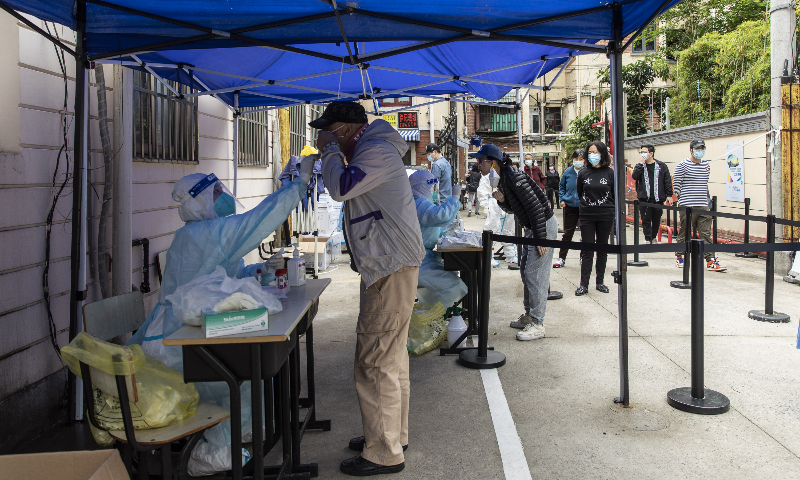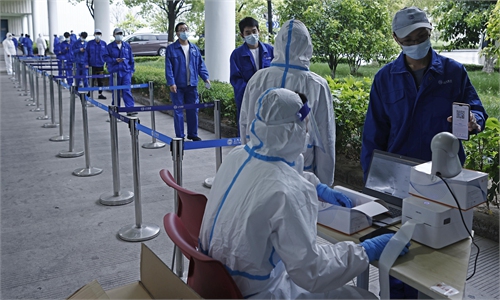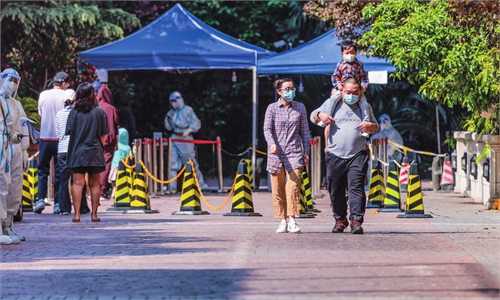Shanghai flare-up claimed 87 lives, sees increasing cluster infections at construction sites, companies

Residents take nucleic acid tests during a lockdown in Shanghai on April 24, 2022. Photo: VCG
Shanghai registered the largest ever daily tally of COVID-19 deaths of 39 on Saturday, bringing the total to 87 lives that the latest flare-up in the city has claimed as of Saturday.
The epidemic is fluctuating at high levels with cluster infections at some construction sites and enterprises increasing amid business resumption, despite the fact that coronavirus infections at community level are dropping and more patients are being discharged from hospitals.
Shanghai registered 1,401 local confirmed cases, 19,657 asymptomatic infections and added 39 deaths on Saturday, bringing the accumulated number of deaths to 87 as of Saturday, according to Shanghai health authority. Most of them were elderly patients with severe underlying conditions that easily evolve into severe cases, which experts noted should draw great attention.
On Saturday, a total of 18,868 patients, including 2,242 confirmed patients and 16,626 asymptomatic infections were discharged from designated and makeshift hospitals in Shanghai. They will be placed under health observation at their residences.
With the joint efforts of the entire society, daily new infections, especially in communities, are gradually decreasing. However, the epidemic situation remains grim and complicated with the daily tally of new infections still high, Zhao Dandan, deputy director of Shanghai Municipal Health Commission, said during a press briefing on Sunday.
The majority of new infections came from construction sites and companies where cluster infections rebounded as the engine of China’s economic development is ramping up business resumption.
Based on the recent epidemic statistics, the proportion of newly discovered positive cases found outside closed-loop management is gradually declining. The newly found cases are generally found in sealed-off and controlled areas and centralized quarantine sites.
According to Zhao, the average age of the 87 death cases was 81.1, with the eldest patient aged 101. All these 87 cases had COVID-19 combined with severe chronic diseases of multiple organs including advanced malignant tumor, serious cardiovascular disease, nervous system disease, cirrhosis at end-stage, diabetes, uremia, and etc, Zhao said.
Except for five cases, most of these patients were not vaccinated and their conditions progressed rapidly after they were hospitalized. They eventually died despite treatment and the immediate causes of the deaths were the underlying diseases, the official said.
A total of 160 severe cases and 19 critical cases are receiving treatment at present. The number of severe and critical patients of COVID-19 is growing these days due to the increase of positive COVID-19 infections lately, Zhao said, urging elderly people eligible for vaccination to take the shots as soon as possible since positive infections with underlying conditions, especially in old people, face high risks of progressing into severe cases or even deaths.
According to Wang Xingpeng, director of Hospital Development Center, the number of elderly patients aged above 70 accounts for 30 percent of the severe patients currently receiving treatment at designated hospitals. Over 60 percent of severe patients have underlying conditions. As many as 40 percent severe patients have at least three underlying diseases, including cardiovascular and cerebrovascular diseases, kidney diseases, metabolic diseases, respiratory diseases, nervous system diseases and malignant tumors.
Three principles will be adhered to in the treatment of the severe patients including paying equal attention to the prevention of light cases developing into severe cases and the treatment of severe cases, equal attention paid to the treatment of COVID-19 as well as underlying diseases, and treatment with the combination of traditional Chinese medicine and Western therapies.
More than 360 experienced clinical experts of critical care from across the city, together with experts from other provinces who came to the help in the combat against the epidemic, have formed nine rescue teams for severe cases and have been stationing at eight city-level designated hospitals to treat the severe and critical cases and those COVID-19 cases combined with underlying conditions.
Among the experts from other provinces who came to help, at least three experts who participated in the fight against COVID-19 in Wuhan in 2020 have already joined the combat in Shanghai. One of them is Qiu Haibo, a deputy president of Zhongda Hospital at Southeast University in Nanjing, East China's Jiangsu Province, as well as an expert sent to assist Shanghai under the National Health Commission. He told the Health Times that the elderly often have a variety of underlying diseases which can easily evolve into severe cases, thus they need to be paid close attention to.
According to Qiu, the severe cases are divided into two categories: one category of patients developing into severe cases from pure light cases and the other category with multiple underlying conditions combined with COVID-19, both of which will pose threats to lives.
At present, Shanghai is endeavoring to make preventions beforehand to prevent asymptomatic infections and mild cases from developing into severe cases.
Global Times


